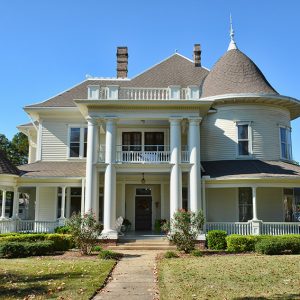calsfoundation@cals.org
Charles Christopher Henderson (1850–1923)
Charles Christopher Henderson was a businessman and philanthropist in southern Arkansas long associated with Arkadelphia Methodist College, which in 1904 was renamed Henderson College in honor of Henderson’s service on the board of trustees and his financial support. The school’s former campus operates as Henderson State University in the twenty-first century. Henderson’s 1906 Queen Anne–style home in Arkadelphia (Clark County) was added to the National Register of Historic Places in 1998, listed as the Captain Charles Christopher Henderson House.
Charles Henderson was born in Scott County on March 17, 1850, the third of eight children of John Henderson and Margaret Mahalia Reed Henderson. The family lived in both Scott and Sebastian counties during his childhood. Henderson was fourteen years old when his father died. Around 1870, Henderson’s mother moved to Arkadelphia to be near her brother and sister, who lived in the community. Henderson worked for a livestock company based in St. Louis, Missouri, and followed his mother to Arkadelphia in 1879. It was around this time that he began to be called “captain.”
Henderson married Laura Bell Hall in 1880 and constructed a home in Arkadelphia the same year. The couple had two daughters and a son. Henderson worked in a number of industries after arriving in Arkadelphia, including cotton and dairies. He began investing in timber and sawmills in the early 1880s and became a partner in a number of firms, including the Arkadelphia Lumber Company, the Nashville Lumber Company, and the Brown-Henderson Improvement and Timber Company. These investments in timber led to additional interests in ten railroad companies, including the Memphis, Paris and Gulf Railroad. In turn, Henderson became active in banking in order to finance various projects and served as the president of Elkhorn Bank from 1905 to 1916.
Active in the local Methodist Church and influenced by a Methodist minister who lived with his family during the Civil War, Henderson helped raise funds for the construction of a new church in Arkadelphia and served as a delegate at various Methodist functions. As Henderson prospered, he built a large home on the north side of the city, directly across the street from Arkadelphia Methodist College, which was founded in 1890 to educate Methodist students south of the Arkansas River. Henderson was appointed to the board of trustees of the college in December 1891. Henderson’s wife was active in the movement to establish the college and took classes at the institution.
Henderson served on the board for more than a decade before he began to make large donations to the college. The college was chronically short of funds and, for approximately fourteen years, operated under a lease with the first president, George Jones. The board repeatedly tried to buy out Jones’s lease but were unable to do so until Henderson found a solution. In 1901, he donated $11,000 to pay off the existing debts of the institution and, over the next three years, led efforts for the board to gain complete control of the institution. This was completed in 1904 when Jones left the college. In honor of Henderson’s efforts, the college was renamed Henderson College. Henderson also became the chairman of the board in 1903, holding this position until 1922.
After the departure of Jones, the board created a three-member committee to run the operations of the college. Committee chair John Hinemon took the responsibility of overseeing daily operations, but Henderson and fellow committee member Eli McDaniel remained heavily involved in all financial decisions. Henderson continued to make large donations or purchases for the college. In 1905, he paid $5,250 to settle a claim for the college and, in 1909, gave $10,000 to pay off additional debts. His business partner Walter Brown, also a member of the board, gave an additional $10,000. In recognition of his support, the name of the institution became Henderson-Brown College in 1911. After a fire in 1914 destroyed the main building on campus, Henderson donated $5,000 to the rebuilding effort.
In 1913, Henderson moved to El Paso, Texas, where he operated banking institutions, but he continued his service on the board. In failing health, he resigned as president of the board in 1922 but continued to serve on the board. He was replaced as chairman by Harvey Couch. Henderson died on June 4, 1923.
After thirty-nine years of Methodist control of the college, the Methodist state convention made the unpopular decision to close Henderson-Brown and combine it with Hendrix College in Conway (Faulkner County). After negotiations with state lawmakers, it was decided to turn control of Henderson-Brown over to the state rather than close its doors. The campus was given to the state in 1929 and began operations as Henderson State Teachers College the same year. The name was changed to Henderson State College in 1967 and to Henderson State University in 1975.
For additional information:
Bledsoe, Bennie Gene. Henderson State University: Education Since 1890. Houston, TX: D. Armstrong, 1986.
Hall, John. Henderson State College: The Methodist Years, 1890–1929. Arkadelphia, AR: Henderson State College Alumni Association, 1974.
Sesser, David. The School with a Heart: Henderson State University at 125. Covington, GA: Bookhouse Group, 2015.
David Sesser
Henderson State University


 Henderson House
Henderson House 



Comments
No comments on this entry yet.